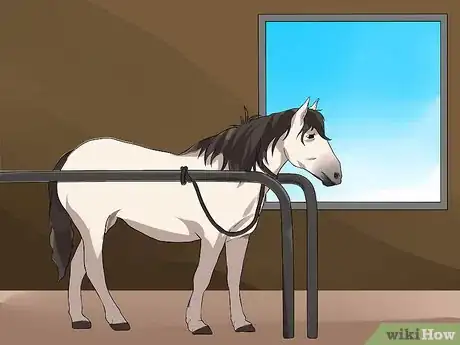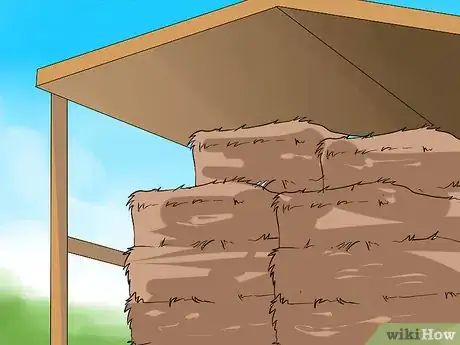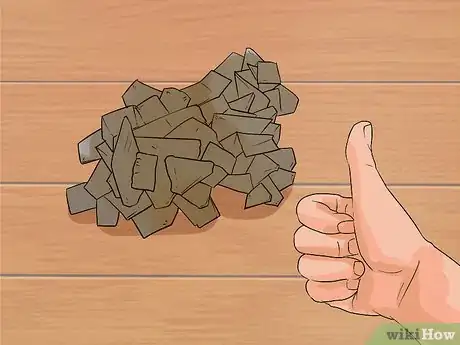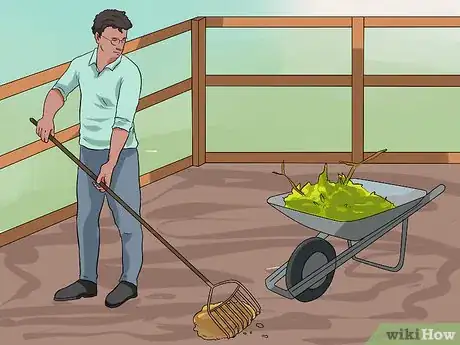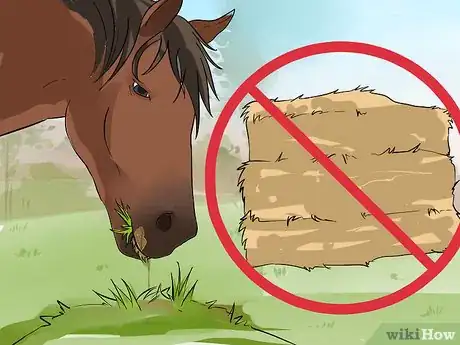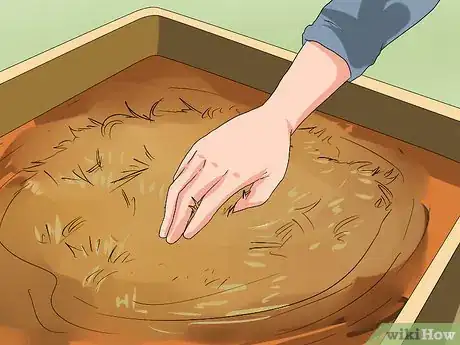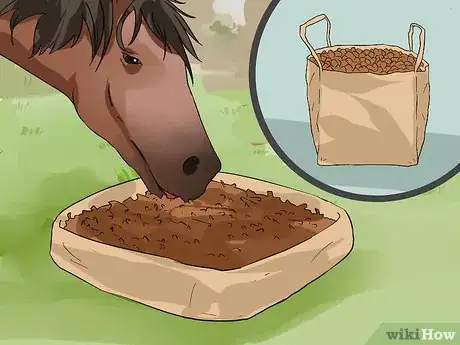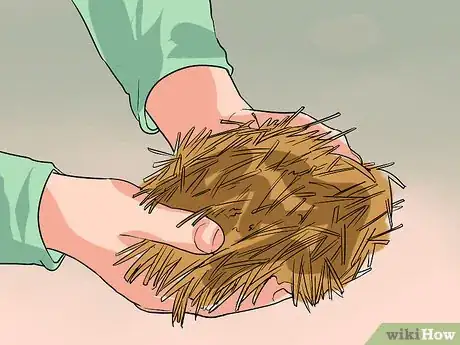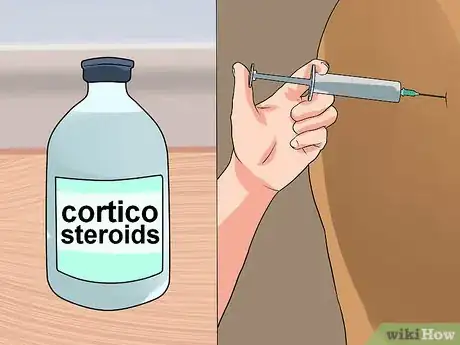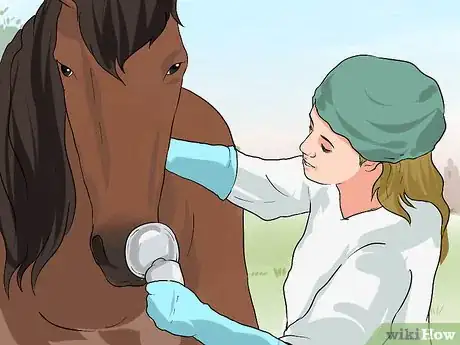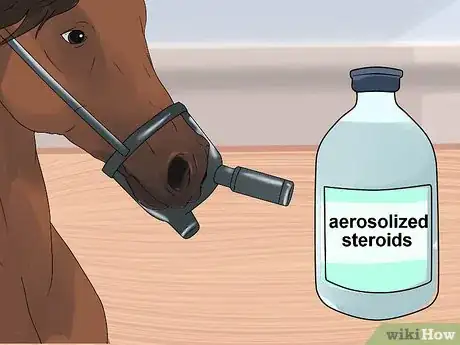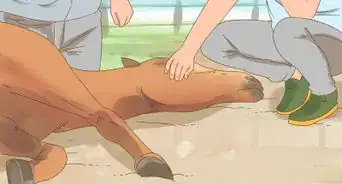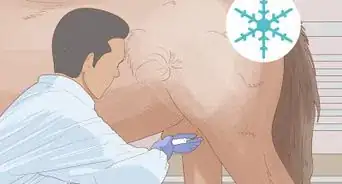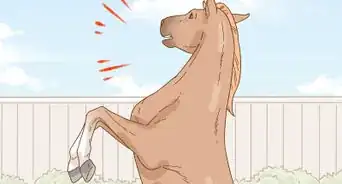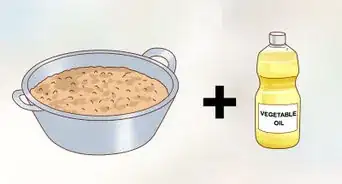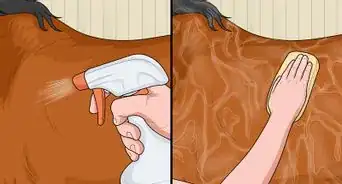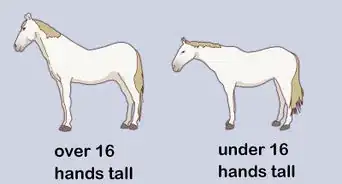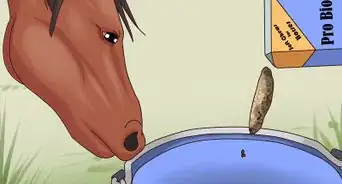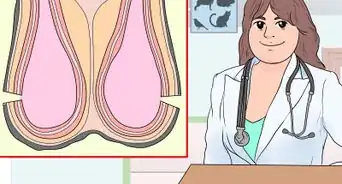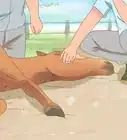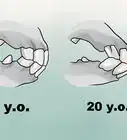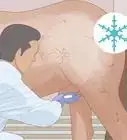This article was co-authored by Ryan Corrigan, LVT, VTS-EVN. Ryan Corrigan is a Licensed Veterinary Technician in California. She received her Bachelor of Science in Veterinary Technology from Purdue University in 2010. She is also a Member of the Academy of Equine Veterinary Nursing Technicians since 2011.
There are 9 references cited in this article, which can be found at the bottom of the page.
wikiHow marks an article as reader-approved once it receives enough positive feedback. In this case, 100% of readers who voted found the article helpful, earning it our reader-approved status.
This article has been viewed 18,745 times.
Heaves, also known as recurrent airway obstruction (RAO), affects a horse’s respiratory tract. Common in adult horses, heaves is an allergic reaction to particles in the environment. The reaction caused by these particles, called allergens, obstructs the airways in 3 ways: inflaming and thickening the lining of the airway (‘bronchiolitis’), constricting the muscle surrounding the airway lining (‘bronchospasm’), and increasing mucus production.[1] If your horse has heaves, his treatment will be lifelong — there is no short-term cure for heaves. With proper treatment, though, your horse can live a long, happy life.
Steps
Managing Your Horse’s Environment
-
1Increase your horse’s time out on pasture. The key to treating heaves is reducing your horse’s exposure to allergens. Since a stable has dust and other allergens in the air, increasing your horse’s pasture time would give him more fresh air and less exposure to allergens. More time at pasture would also give your horse a chance to eat fresh grass, which does not have heaves-inducing allergens.[2]
- Heaves that is made worse by stabling is called barn-associated RAO. If your horse has this form of heaves, leave him out on pasture as much as possible.[3]
- Another form of heaves, called pasture-associated RAO, can actually get worse with pasture time. If your horse has this type of heaves, limit his pasture time to only the winter months.[4]
- If you are not able to increase your horse’s pasture time, house him in a part of the stable that doesn’t have a lot of airborne allergens.[5] This could be a stall located closest to the stable entrance or near a window.
- At the time of diagnosis, your vet will be able to tell you the form of heaves affecting your horse.
-
2Keep your horse’s stable well ventilated. Whenever you bring your horse back in from pasture, the stable should be well ventilated. Keep the stable's windows and doors open as often as possible. Fresh air coming in from the outside will decrease the amount of allergens in the stable.[6]
- If you keep the windows or doors open during the colder months, place a blanket on your horse to keep him warm. Make sure the blanket fits him—the straps of an ill-fitting blanket can leave rub marks and sores on a horse’s body.[7]
- Use large overhead fans to promote airflow and circulation throughout the barn. You can also use box fans to increase the airflow within your horse’s stall. Either way, make sure clean air is flowing into the horse’s stall.
Advertisement -
3Store hay properly. Since hay contains allergens, storing it overhead could increase the level of those allergens in the air. Rather than storing the hay overhead, keep it in an area completely removed from your horse, such as a storage trailer or other weatherproof building.[8]
- If you must store hay in the barn, cover the hay with a large tarp to decrease the amount of circulating allergens.
-
4Use low-dust bedding in your horse’s stall. Low-dust bedding is crucial to treating heaves in horses. Examples of low-dust bedding are chopped paper and chopped cardboard. Straw is extremely dusty and is not recommended for bedding.[9]
- Particles in straw are fairly large and may not get far enough into the lungs to cause airway inflammation. Nonetheless, you would be better off not taking the risk of worsening your horse’s heaves with straw bedding.
-
5Clean your horse’s stall. Cleaning your horse’s stall will also reduce your horse’s exposure to allergens, as long as it’s done correctly. After putting your horse out to pasture, use a metal pitchfork to remove the manure and dirty bedding. Then, use a shovel to pick up whatever fell through the slats of the pitchfork. If you see any damp spots on the floor (indicating urine), spray them with an absorbent deodorizer to remove the scent of ammonia.[10]
- Ammonia, which comes from decomposing urine, can irritate your horse’s airways.
- It can take up to an hour for air particles to drift back down after cleaning, so do not return your horse to his stall until several hours after cleaning it.[11]
- Do not sweep the stable frequently. Frequent sweeping will increase the level of airborne allergens.[12]
- Before sweeping, consider wetting the floor to reduce the amount of dust flying into the air.
- If you decide to sweep or use a blower to clean the stalls or barn aisle, do so when all the horses are turned out and the barn is empty.
-
6Wet down indoor arenas or arenas with little to no window or ventilation. Spraying down the arena will minimize, to a small degree, the amount of dust flying around while working your horse. Wetting down the arena should keep your horse more comfortable while exercising.
Managing Your Horse’s Diet
-
1Eliminate hay from your horse’s diet. Making changes to your horse’s diet will also treat his heaves. Since eating hay is a common cause of heaves in horses, you should take hay completely out of your horse’s diet. In particular, do not feed your horse round bale hay, which has a high dust content.[13]
- Avoiding hay is especially important if your horse has severe heaves.
- When a horse eats hay, especially round bale hay, he buries his nose in it. Moving his nose through the hay causes dust to fly up into the air, causing him to breathe it in, which severely exacerbates heaves.
-
2Soak your horse’s hay before feeding it to him. If removing hay from your horse’s diet is not possible, consider soaking it in water before feeding it to him. Soaking the hay overnight will reduce the hay’s nutrient content, so soak it for only about 15 minutes.[14] Make sure your horse eats the immediately. If not, the wet hay will dry out and grow mold.
- Soaking hay can be helpful for mild cases of heaves.[15]
- Unfortunately, soaking hay can worsen a severe case of heaves.[16]
- Discuss the pros and cons of soaking hay with your vet. They can recommend whether it would be a good treatment strategy for your horse.
- Consider getting a large commercial soaker that will steam your hay in big batches if you are feeding a lot of horses. Hay steamers wash the hay and kill mold and bacteria.
-
3Feed your horse a complete pelleted feed. While out on pasture, your horse will have access to grass, which is one of the best things your horse can eat. In the winter, when there is not much grass on the ground, feed your horse a complete pelleted feed, which is low in dust and provides the nutrients your horse needs to stay healthy.[17]
- Consider feeding your horse the pelleted feed as a supplement to grass.[18]
- Follow the label instructions to determine how much feed to give your horse.
- Talk with your vet if you are not sure which pelleted feed to purchase for your horse.
-
4Add low-dust foods to your horse’s diet. Other than grass and pelleted feed, several other low-dust foods are good for horses with heaves. Examples of these foods are silage, alfalfa pellets, and alfalfa cubes.[19] Alfalfa is a type of hay, but is low in dust when in pelleted or cubed form.
- Your horse may actually prefer hay cubes or silage over the complete feed.[20]
-
5Feed your horse at chest level. Feeding your horse off the ground keeps his airway open and keeps him from inhaling dust and allergens off the ground. It also allows for any bits of hay and dust to settle on the ground below where your horse won’t eat.
Treating Your Horse’s Heaves with Medication
-
1Give your horse systemic corticosteroids. If your horse has mild or moderate heaves, then changes to his diet and environment could be all that he needs for treatment.[21] Many horses with heaves, though, require additional treatment with medications. Corticosteroids (steroids, for short) reduce inflammation, making them very effective for heaves treatment.[22]
- Steroids can be given either intravenously or by mouth.[23]
- Intravenous dexamethasone, one type of steroid, is effective in treating severe cases of heaves. Prednisolone, another steroid, has fewer side effects than dexamethasone. It is usually used to treat less severe cases of heaves.[24]
- Prolonged steroid use can have serious side effects in horses. To prevent these side effects, your vet will gradually taper your horse’s steroid dosage.[25]
-
2Administer a bronchodilator. A bronchodilator relaxes the airways, allowing a horse to breathe more easily. This type of medication can provide immediate relief to airway obstruction. Bronchodilators come in several formulations: injectable, oral, and aerosolized. Aerosolized bronchodilators, which a horse can breathe in, are especially useful for horses with severe heaves.[26] [27]
- Bronchodilators can also clear mucus from the lungs. Their effects last about 1 to 3 hours.
- Clenbuterol and albuterol are types of bronchodilators that are available a local drugstores with a veterinarian’s prescription.
- Because bronchodilators do not treat inflammation, they cannot be the sole treatment for heaves. They must be given with steroids. [28]
-
3Consider aerosolized steroids. If your horse needs long term steroid use, your vet may recommend a low-dose, aerosolized steroid. An aerosolized steroid has fewer side effects than a systemic steroid. Be aware that aerosolized steroids are expensive, since you would have to purchase the mask to administer the medication. Despite the cost, this formulation would provide targeted relief of your horse’s airway inflammation.[29]
- Aerosolized steroids are not given when beginning heaves treatment because the airways may be too obstructed for the medication to work effectively.[30]
-
4Avoid certain medications. Non-steroidal anti-inflammatory drugs and antihistamines have not shown much benefit in horses with heaves.[31] Do not use these medications to treat your horse if has heaves.
Expert Q&A
-
QuestionWhat causes heaves in a horse?
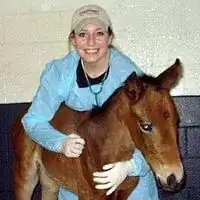 Ryan Corrigan, LVT, VTS-EVNRyan Corrigan is a Licensed Veterinary Technician in California. She received her Bachelor of Science in Veterinary Technology from Purdue University in 2010. She is also a Member of the Academy of Equine Veterinary Nursing Technicians since 2011.
Ryan Corrigan, LVT, VTS-EVNRyan Corrigan is a Licensed Veterinary Technician in California. She received her Bachelor of Science in Veterinary Technology from Purdue University in 2010. She is also a Member of the Academy of Equine Veterinary Nursing Technicians since 2011.
Licensed Veterinary Technician Allergens, usually molds and pollens found in hay, when inhaled by the horses cause irritation and chronic inflammation called 'heaves'.
Allergens, usually molds and pollens found in hay, when inhaled by the horses cause irritation and chronic inflammation called 'heaves'. -
QuestionCan you cure a horse with heaves?
 Ryan Corrigan, LVT, VTS-EVNRyan Corrigan is a Licensed Veterinary Technician in California. She received her Bachelor of Science in Veterinary Technology from Purdue University in 2010. She is also a Member of the Academy of Equine Veterinary Nursing Technicians since 2011.
Ryan Corrigan, LVT, VTS-EVNRyan Corrigan is a Licensed Veterinary Technician in California. She received her Bachelor of Science in Veterinary Technology from Purdue University in 2010. She is also a Member of the Academy of Equine Veterinary Nursing Technicians since 2011.
Licensed Veterinary Technician There is no cure for heaves but mild-moderate cases can be managed with environmental changes and medications.
There is no cure for heaves but mild-moderate cases can be managed with environmental changes and medications. -
QuestionCan horses have COPD?
 Ryan Corrigan, LVT, VTS-EVNRyan Corrigan is a Licensed Veterinary Technician in California. She received her Bachelor of Science in Veterinary Technology from Purdue University in 2010. She is also a Member of the Academy of Equine Veterinary Nursing Technicians since 2011.
Ryan Corrigan, LVT, VTS-EVNRyan Corrigan is a Licensed Veterinary Technician in California. She received her Bachelor of Science in Veterinary Technology from Purdue University in 2010. She is also a Member of the Academy of Equine Veterinary Nursing Technicians since 2011.
Licensed Veterinary Technician Yes. Chronic Obstructive Pulmonary Disease or COPD is the formal name for what is commonly known as heaves in horses.
Yes. Chronic Obstructive Pulmonary Disease or COPD is the formal name for what is commonly known as heaves in horses.
Warnings
- Because horses have large lung capacities, your horse’s airway inflammation may be extensive.⧼thumbs_response⧽
- Silage can contain the toxin causing botulism. Make sure your horse is vaccinated against botulism before feeding him silage.[34]⧼thumbs_response⧽
- Feeding your horse round bale hay can cause treatment failure, especially if you keep him out on pasture.[35]⧼thumbs_response⧽
References
- ↑ http://www.veterinaryextension.colostate.edu/menu2/equine/treatingheaves-1.pdf
- ↑ http://www.merckvetmanual.com/mvm/respiratory_system/respiratory_diseases_of_horses/recurrent_airway_obstruction_in_horses.html
- ↑ http://edis.ifas.ufl.edu/vm142
- ↑ http://edis.ifas.ufl.edu/vm142
- ↑ http://www.ca.uky.edu/agc/pubs/asc/asc172/asc172.pdf
- ↑ https://www.extension.purdue.edu/extmedia/id/id-444-w.pdf
- ↑ http://www.extension.umn.edu/agriculture/horse/care/equine-winter-care/#shelter
- ↑ http://www.extension.umn.edu/agriculture/horse/care/equine-winter-care/#shelter
- ↑ http://edis.ifas.ufl.edu/vm142
- ↑ http://www.horsechannel.com/horse-exclusives/better-stall-cleaning.aspx
- ↑ http://www.extension.umn.edu/agriculture/horse/care/equine-winter-care/#shelter
- ↑ http://www.ca.uky.edu/agc/pubs/asc/asc172/asc172.pdf
- ↑ http://edis.ifas.ufl.edu/vm142
- ↑ http://www.extension.umn.edu/agriculture/horse/care/equine-winter-care/#shelter
- ↑ http://www.merckvetmanual.com/mvm/respiratory_system/respiratory_diseases_of_horses/recurrent_airway_obstruction_in_horses.html
- ↑ http://edis.ifas.ufl.edu/vm142
- ↑ http://www.ca.uky.edu/agc/pubs/asc/asc172/asc172.pdf
- ↑ http://www.merckvetmanual.com/mvm/respiratory_system/respiratory_diseases_of_horses/recurrent_airway_obstruction_in_horses.html
- ↑ http://www.ca.uky.edu/agc/pubs/asc/asc172/asc172.pdf
- ↑ http://www.merckvetmanual.com/mvm/respiratory_system/respiratory_diseases_of_horses/recurrent_airway_obstruction_in_horses.html
- ↑ http://edis.ifas.ufl.edu/vm142
- ↑ http://www.merckvetmanual.com/mvm/respiratory_system/respiratory_diseases_of_horses/recurrent_airway_obstruction_in_horses.html
- ↑ http://www.veterinaryextension.colostate.edu/menu2/equine/treatingheaves-1.pdf
- ↑ edis.ifas.ufl.edu/vm142
- ↑ http://www.ca.uky.edu/agc/pubs/asc/asc172/asc172.pdf
- ↑ http://www.merckvetmanual.com/mvm/respiratory_system/respiratory_diseases_of_horses/recurrent_airway_obstruction_in_horses.html
- ↑ http://www.ca.uky.edu/agc/pubs/asc/asc172/asc172.pdf
- ↑ edis.ifas.ufl.edu/vm142
- ↑ edis.ifas.ufl.edu/vm142
- ↑ http://www.ca.uky.edu/agc/pubs/asc/asc172/asc172.pdf
- ↑ http://www.merckvetmanual.com/mvm/respiratory_system/respiratory_diseases_of_horses/recurrent_airway_obstruction_in_horses.html
- ↑ http://vetmed.illinois.edu/pet_column/barn-air-quality-affects-horses-breathing/
- ↑ http://www.ca.uky.edu/agc/pubs/asc/asc172/asc172.pdf
- ↑ http://www.ca.uky.edu/agc/pubs/asc/asc172/asc172.pdf
- ↑ edis.ifas.ufl.edu/vm142
About This Article
While there is no short-term cure for heaves, you can treat your horse's heaves throughout its lifetime by increasing its pasture time, so it gets more fresh air and is less exposed to allergens. You can also improve the airflow in your horse's stable by opening the windows and adding a ventilation system or large overhead fans. Since hay is a common cause of heaves in horses, make sure to cover any hay you store in your barn with a large tarp, so the allergens stay mostly contained, or keep hay in another building entirely. To further protect your horse, talk to your veterinarian to see if it would be safe to eliminate hay from your horse's diet completely, or try soaking it in water before feedings to remove excess dust. For more advice from our Veterinary co-author, such as how to treat your horse's heaves with medication, keep reading!

